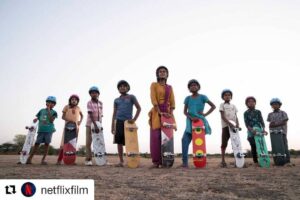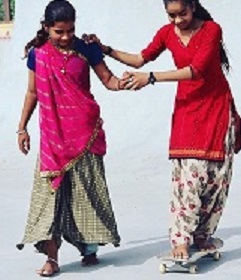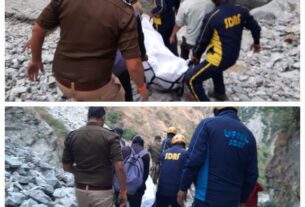Micro Mobility is any type of transportation that is lightweight yet capable of transporting a person from one place to another. For Example, Cycles, Bikes, e-Bikes (both docked and dockless), e-scooters (both docked and dockless), roller skates, tricycles, mobility scooter, unicycle, golf carts, kick scooters, onewheel, quadracycles, wheelchairs, segways, personal transporters, and Skateboards. These modes are usually seen in urban areas for commuting over shorter distances.

Skateboarding as a micro-mobility mode has been popular in many countries like USA, Japan, England, Brazil, Germany, Australia, China, Denmark and others for teenagers, college students and adults.
A normal skateboard has a speed of 10-20 Kmph, and as a sport, it’s a great way to reduce stress, improving coordination and balance. Skateparks boost community bonding and have a positive impact on local businesses as well along with utilizing unused space. Skateboarding has also entered as a sport in the Olympics since 2021.
Earlier, it was considered a novel sport in our country and as a child, there was no access to skateboards. But, since last 15 years, skateboards are selling at toy shops and sports shops alike in Indian market. Nowadays, even electric skateboards are available in the market. A skateboard in India sells for as less as Rs 500/- to Rs 50,000/- depending on the quality and use. General use skateboard is cheaper than the ones used for professional sport. An electric skateboard may be priced at an average of around Rs35,000/- to even beyond a sum of rupees one lakh. At present there are no special right of ways for skateboards in our country. We as a country, are still understanding the need to have separate pedestrian and bicycle pathways, the skateboard inclusion in our streets is a long way. However, within no-car zones like markets, universities, residential complexes, parks, and open spaces with restriction to motorized traffic, these can still be used safely.
Skateboard wheels have gone through a lot of changes since the early 1900s. Kids used to take roller skate wheels and attach them to a wooden plank. Early skateboard wheels were made of steel which didn’t exactly offer a comfortable ride without any traction. It wasn’t until the 70’s when Frank Nasworthy in 1972 introduced the first polyurethane skateboard wheels. The first skateboard trick is attributed to Alan Gelfand and he called this trick an “ollie”. He was able to get his board into the air in a bowl without touching it. Later Rodney Mullen adapted it to the street and amazed people with his “flatland ollie”. This eventually led to the rise of street skateboarding. Elissa Steamer was the first official female pro skater. In 1950s it used to be a male dominated sport but at present approximately 24% of commuter share is attributed to females.
The fastest person on a skateboard is Kyle Wester. His top speed was measured at 143.89 kmph. That’s enough to get fined for going over the speed limit of most freeways in the US. Skateboarding is one of the more popular ‘sports’ in the US. In 2016 there were about 6.4 million skateboarders in the US and 85 million worldwide. The vast majority is under the age of 18 & this number is probably going to get bigger over the next five years as the industry will continue to grow.
Surf City was the first park that opened in 1965 in Tucson, Arizona. The GMP Skatepark in Guangzhou, China is 16,900 square meters. There is an estimate of over 3500 skateparks worldwide and over 500 in the US alone.
Is it a dangerous sport? No, not at all, in fact, more people playing basketball or cycling land up in injuries than people who are on skateboard as per statistics from US Hospitals. Netflix recently released a movie, “Skater Girl”, which is based on the life of a 16-year-old girl from Rajasthan and her sheer grit for the skateboarding sport.

The story revolves around the protagonist girl who happens to meet a British-Indian woman and they end up creating a skatepark in a village called Khempur, 50 Kms from Udaipur city. The most interesting part is that during the shooting of the movie, they built up a set in Khempur and later on donated the skatepark constructed for the movie to the locals to use for their skating interests. The idea of leaving behind the skatepark as a legacy was the brainchild of film maker Manjari Makijany, who happens to be the daughter of Mac Mohan, who played Sambha in the movie Sholay. The Desert Dolphin skatepark is sprawled across 14,500 sqft. In Khempur Village. The movie was made to create a social change which portrays social inclusion of gender, urban sports, micro-mobility, and community building.
It is a very special movie, a great message, and for mobility enthusiasts, a great gift. The skatepark is open to all since the wrap up of the shoot in 2019. The skate park has become not only a tourist destination but also a place where local kids are learning skateboarding and changing the course of their lives. Families from nearby towns are visiting with their kids on weekends to let their kids’ practice.
Manjari’s family has set up a trust, “The Living Grace Foundation” which supports by providing skateboards, free training, and safety equipment to the children. It is one of India’s largest and advanced skatepark and was built by the crew of 100 Ramps, a Bengaluru skate park construction company.
Four village children have gone on to represent Rajasthan in the National Skateboarding Championship in Chandigarh. The legacy left behind by the movie is not only changing lives of local children by giving them an alternative sport but also is shaping their future.
Author

Dr. Mansha Swami is a Transportation Engineering Consultant, Researcher and Academician and is currently working as a Postdoctoral Research Associate at the University of Texas at Arlington, United States. She has been working as an advisor to various government, semi-government and private organizations in transportation planning, urban multimodal transport, traffic, road safety and highway sector in India. Have been Consulting in the following domains in Transportation since a decade. Transportation Planning, Multimodal Public Transportation Planning, Traffic Engineering, Road Safety Audit and Planning – Accident Studies, Black spot rectification, Forensic Crash Investigation & Sustainable Urban Transport Policy Design She pursued her PhD. in Transportation Planning & Engineering from Indian Institute of Technology, Roorkee (India) and Masters in Transportation from SVNIT, Surat (India).



